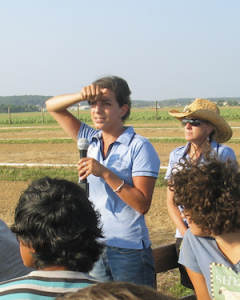Always positive. Wonderful to work with. An invaluable resource. Accolades like these don’t just pop up out of nowhere. In Sandra Menasha’s case, they speak to the qualities that earned her an Excellence in IPM award.

Menasha is a vegetable specialist with Cornell Cooperative Extension (CCE) on eastern Long Island. A few short decades ago, Long Island was blanketed with working farms that shipped produce, mostly potatoes, to New York City and points west. Now a different sort of blanket covers much of western Long Island — suburbs. But Suffolk County in eastern Long Island, with its equable climate and a soil both sandy and rich, still hosts several hundred working farms. Some go back 10 or 15 generations.
Menasha works with these growers. She scouts their fields — a classic IPM tactic — alerting them to disease and insect pests (and diseases are pests) as well as the beneficial organisms that can save a crop. After all, about the costliest thing a grower can do is treat for something that isn’t there. And she digs deep into each pest’s why, when, and what, since the cause of seemingly similar problems could be one thing one year but another the next. She also holds twilight meetings at the farms to demonstrate her research to other growers.

What research? Well, lately Menasha has worked with plant pathologist Margaret McGrath at Cornell’s Horticultural Research and Extension Center. Their focus: soil-borne diseases that can outlast even the most careful crop rotations (another classic IPM tactic). Diseases that can cost growers as much as $4,000 per acre. Menasha and McGrath wanted to test biofumigants: plants that, if planted early and tilled in before the main crop, release chemicals that do in soil pests. It’s a new technique that has “IPM” written all over it. Right now farmers are using biofumigation on well over 400 acres. The Long Island Farm Bureau expects that number to grow.
Yes, planting two crops instead of one is more labor-intensive. “But you also get more benefits,” says grower Don McKay. “The mustard decomposes into organic matter that enriches the soil.” McKay uses it on pumpkins, a high-value crop on Long Island and one plagued by a soil-borne blight. And Menasha? “Sandy’s always on it,” he says. “Without her, I’d have given up on pumpkins.”
Sandra Menasha received her award at the Empire State Fruit and Vegetable Expo in Syracuse, NY.